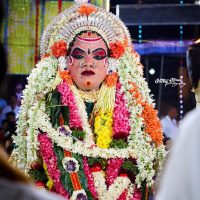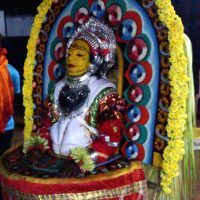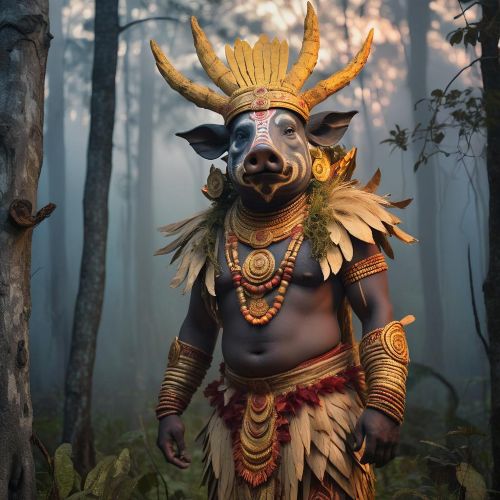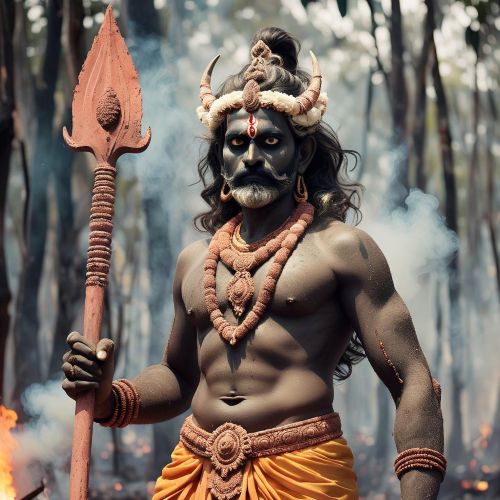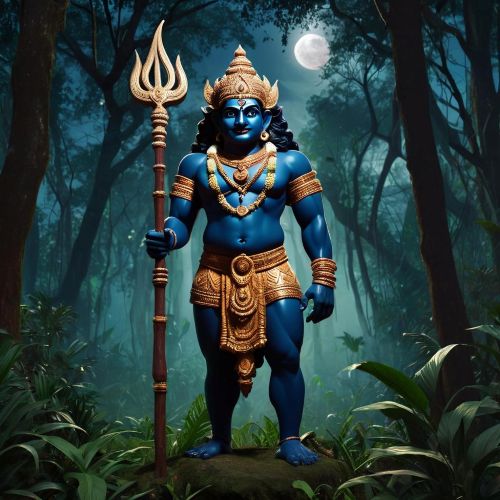Chavundi : The Fierce Guardian Spirit of Tulu Nadu
Listen
At a glance
| Description | |
|---|---|
| Origin | Indian Mythology |
| Classification | Spirits |
| Family Members | Panjurli, Guliga, Huli (Brothers) |
| Region | India |
| Associated With | Protection |
Chavundi
Introduction
Among the pantheon of Daivas venerated in Tulu Nadu—the lush coastal belt of Karnataka—Chavundi stands out as one of the most formidable and awe-inspiring spirits. Deeply rooted in the Bhoota Kola tradition, she represents divine wrath, justice, and protection. Unlike benevolent spirits such as Panjurli, who symbolize prosperity and fertility, Chavundi embodies the destructive yet purifying force of feminine energy. Her arrival in ritual or lore signifies the cleansing of moral decay, punishment of the wicked, and restoration of ancestral order. Fierce, untamed, and utterly incorruptible, Chavundi is both protector and punisher, her presence reminding devotees that divinity can emerge not only in compassion but also in unyielding fury.
Physical Traits
Chavundi’s appearance captures the very essence of primal divinity—terrifying yet transcendent. She is often visualized with ash-smeared skin, matted hair, and eyes glowing with fiery intensity. Her skeletal frame, garlanded with skulls and bones, mirrors the imagery of cremation-ground goddesses from Tantric iconography, representing her dominion over death and transformation. During Bhoota Kola performances, impersonators channel her ferocity through striking costumes—blackened faces, crimson streaks, blazing torches, and frenzied movements that evoke both dread and devotion.
The tiger is her symbolic vahana (mount), embodying her unstoppable energy and authority over life’s wild, chaotic forces. Some local legends describe her spectral form appearing near sacred ponds or forest shrines, her presence marked by sudden heat or a chilling wind. Every element of her iconography—from her ornaments to her trance-like gestures—expresses her role as a liminal being who transcends the boundaries between life and death, purity and decay, devotion and fear.
Family
Chavundi’s mythological roots intertwine ancestral folklore with echoes of pan-Indian goddess traditions. While she shares attributes with Chamunda—the fierce aspect of Durga who destroyed the demons Chanda and Munda—Chavundi in Tulu cosmology is not a goddess of temples but a Daiva born from the collective memory and spirit of the land.
She is considered the sister of Guliga Daiva and one of the four primary guardian spirits of Tulu Nadu, alongside Panjurli and Huli Daiva. Together, they form the Dharmarakshaka Chaturamukha—the fourfold protectors of cosmic and social order. In oral traditions, Chavundi’s origin often stems from acts of betrayal or desecration, where she emerges from blood or fire to avenge a broken promise and restore divine justice. Unlike deities tied to celestial myths, Chavundi’s power is rooted in the soil, the forests, and the ancestral memory of the region.
Other names
Chavundi’s identity flows across linguistic and cultural boundaries. Locally, she is also known as Pilichavundi or Pilchandi, terms that connect her to tiger symbolism and distinguish her from Chamundi of Mysuru. In some oral dialects, names like Choudi or Chavundi Daiva are used interchangeably, though they always refer to her role as a Daiva—a regional spirit rather than a mainstream goddess.
Across India, parallels to Chavundi appear in fierce feminine deities such as Rakteshwari of coastal Karnataka, Charchika of Odisha, and Chamundeshwari of Chamundi Hill. This syncretism highlights how feminine divine rage manifests differently across geography but serves a shared cosmic function—destruction of evil and protection of the moral order.
Powers and Abilities
Chavundi’s powers extend beyond the mythic—they influence the physical, moral, and ecological realms. In Bhoota Kola rituals, she is invoked through Daiva Narthana (spirit dance), where the performer becomes her living vessel. Through possession, Chavundi speaks, judges disputes, blesses devotees, or delivers warnings.
Her divine wrath is feared and revered in equal measure. She is invoked during times of imbalance—whether caused by social injustice, ecological destruction, or spiritual impurity. Local belief holds that she punishes those who defile sacred groves or violate ancestral oaths, ensuring that harmony between humans and nature remains intact. Her fiery energy is transformative—burning away deceit, pride, and corruption, leaving behind truth and renewal.
Chavundi is also seen as a purifier of the soul. Devotees facing personal crises or moral guilt approach her not for mercy but for release through confrontation. Her terrifying visage forces them to acknowledge their inner darkness, symbolizing spiritual rebirth through fear and humility.
Chavundi’s worship is central to the Bhoota Kola tradition—a living ritual heritage of coastal Karnataka that blends dance, trance, music, and divination. Her ceremonies are conducted at night, when the veil between worlds is thinnest. Drummers, torchbearers, and priests create an atmosphere charged with intensity as the impersonator, clad in elaborate attire, enters a deep trance believed to be divine possession.
During this state, Chavundi is said to descend upon the human vessel, addressing the gathered devotees directly. Offerings of toddy, rice, and betel leaves are made, and in older traditions, animal sacrifices marked the ritual’s culmination. These ceremonies serve not only as acts of worship but also as community courts—where disputes are resolved and ancestral justice is enacted under her authority. Through these rituals, Chavundi remains a living force, her power experienced rather than merely believed.
Modern Day Influence
In recent years, Chavundi’s presence has reemerged in the cultural spotlight, largely due to a revived interest in the Bhoota Kola tradition following the popularity of the film Kantara (2022). Her image now symbolizes more than fear—it embodies resistance, justice, and feminine strength. Among younger generations in Tulu Nadu, Chavundi has become a figure of cultural identity and environmental consciousness, representing the region’s connection to ancestral land and its protection.
Artists and scholars interpret her as an archetype of retributive justice—one that echoes in the global conversations around feminism, ecology, and indigenous spirituality. Her worship reminds modern society that power need not always be gentle; it can also roar, cleanse, and reclaim. Through fire, dance, and possession, Chavundi continues to guard the moral pulse of Tulu Nadu, proving that ancient spirits still walk among those who remember them.
Related Images
Source
Mashable ME. (2022). Kantara: Chapter 1 ending—Who is Chavundi? All deities, all the twists and final betrayal explained. Retrieved from https://me.mashable.com/entertainment/61839/kantara-chapter-1-ending-who-is-chavundi-all-deities-all-the-twists-and-that-final-betrayal-explaine
Tamil Delight. (2025, October 10). Every detail of daivas has been beautifully portrayed in this movie… [Facebook post]. Retrieved from https://www.facebook.com/tamildelight/posts/every-detail-of-daivas-has-been-beautifully-portrayed-in-this-movie-there-is-a-t/1113578540885625/
RL Narayanan. (2025, October 10). The Daiva replied: ‘I shall not. But my sister shall.’… [Tweet]. Retrieved from https://x.com/rlnarayanan/status/1976638736550248937
Instagram. (2025, May 13). Chavundi Daiva is a fierce guardian spirit worshipped in coastal Karnataka’s Bhootha Kola tradition… [Reel]. Retrieved from https://www.instagram.com/reel/DIolwtCTRFx/?hl=en
Wikipedia. (2023). Chamunda. In Wikipedia. Retrieved from https://en.wikipedia.org/wiki/Chamunda
Reddit. (2025, October 16). Anyone know about maa sankebaare? r/hinduism. Retrieved from https://www.reddit.com/r/hinduism/comments/1o8b2i4/anyone_know_about_maa_sankebaare/
Instagram. (2025, November 4). Panjurli, Guliga, Huli Daiva, and Chavundi—the divine guardians of Tulunadu… [Post]. Retrieved from https://www.instagram.com/p/DQosZknCak4/
Frequently Asked Questions
Who is Chavundi in Tulu mythology?
Chavundi is a fierce guardian spirit or Daiva from Tulu Nadu, worshipped in the Bhoota Kola tradition as a protector, avenger, and enforcer of divine justice.
Is Chavundi the same as Chamunda?
Although they share similar attributes, Chavundi is distinct from the pan-Indian goddess Chamunda. She is a local spirit deity specific to Tulu Nadu’s ancestral traditions.
How is Chavundi worshipped?
Chavundi is venerated through Bhoota Kola rituals involving trance dance, possession, drumming, fire offerings, and community judgment ceremonies.
What does Chavundi symbolize?
Chavundi represents divine wrath, feminine power, ancestral justice, and the protection of natural and moral balance in the world.
Why is Chavundi significant today?
Chavundi’s resurgence in popular culture reflects renewed interest in indigenous spirituality, environmental protection, and the celebration of fierce feminine divinity in modern India.



